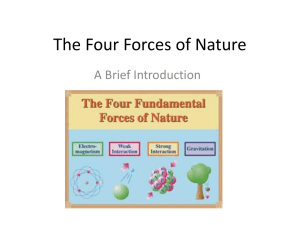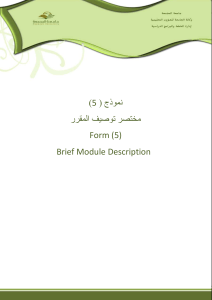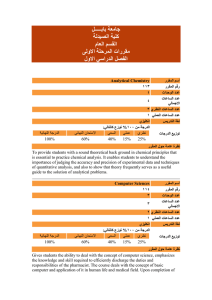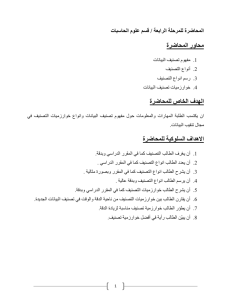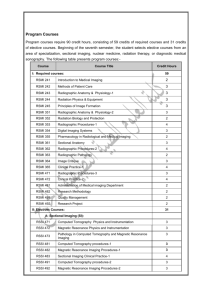first lecture - الدكتورة / زينب بنت زكي الفل
advertisement
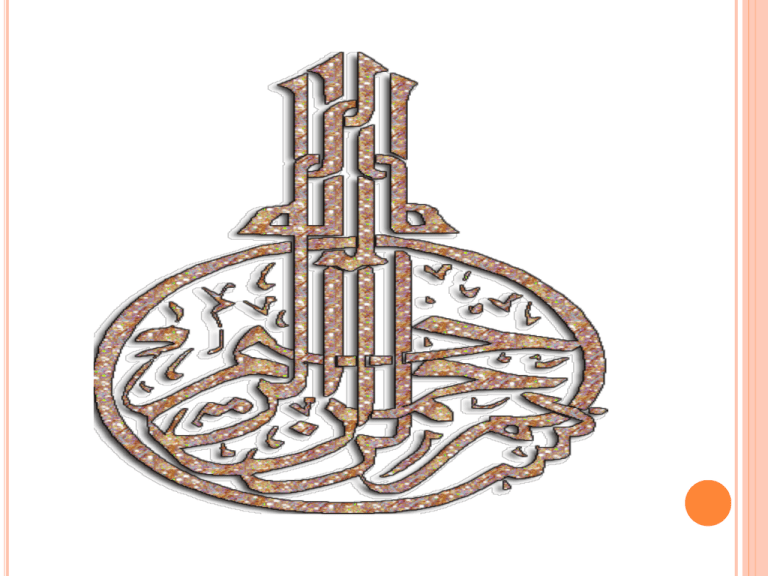
INTRODUCTION TO NUCLEAR PHYSICS APHY 272 Dr. Zainab Z. Alfull تحديد المقرر والمعلومات العامة اسم المقرر و رمزه :مقدمة في الفيزياء النووية 272 -فزت . الساعات المعتمدة 2 :ساعات ( 2نظري ). البرنامج أو البرامج التي يتم تقديم المقرر ضمنها ( ،بكالوريوس العلوم التطبيقية ) اسم عضو هيئة التدريس المسئول عن تدريس المقرر :د زينب زكي الفل المستوى أو السنة التي سيتم تقديم هذه المقرر فيه :المستوى الرابع المتطلبات المسبقة لهذه المقرر(إن وجدت 251 :فزت األهداف يهدف هدا المقرر إلى تعريف الطالب بالخصائص األساسية للنواة كما يلم الطالب بعملية النشاط اإلشعاعي وأيضا ً يتعرف الطالب على أنواع اإلشعاعات المختلفة وتفاعل اإلشعاع مع المادة و كذلك يتعرف الطالب على الكواشف النووية المختلفة ومدى تطبيقها. وصف المقرر( :مالحظة :يرفق الوصف العام للمقرر الموجود في النشرة أو الدليل بالقسم) الخواص األساسية للنواة :رقم الكتلة " "Aورقم الشحنة الكهربية " "Zللنواة الذرية -شحنة النواة الذرية " "Zالكتلة والطاقة ووحدات قياسها -نصف قطر النواة -اللف المغزلي (المغزلية) -العزم المغناطيسي -الندية وقانون حفظها -العزم الكهربي رباعي القطب -المغزلية األيزوتوبية (اللف األيزوتوبى) -طاقة الترابط النووي (طاقة الترابط للنيوكلون – صور أخرى لطاقة ترابط النواة) النشاط اإلشعاعي :أسس نظرية التحلل في النشاط اإلشعاعي -ثابت التحلل وفترة عمر النصف ومتوسط العمر-التحوالت النووية المتتالية -االتزان اإلشعاعي اإلشعاع والمادة :جسيمات ألفا -المدى والطاقة لجسيمات ألفا -جسيمات بيتا-المدى والطاقة لجسيمات بيتا -االستطارة الخلفية لجسيمات بيتا -امتصاص أشعة جاما (التأثير الكهروضوئي – استطارة كومبتون – إنتاج أزواج اإللكترونات والبوزيترونات) كواشف اإلشعاعات النووية :مقدمة-حركة اإللكترونات واأليونات فى الغازات (الحركة اإلنسيابية – اإللتصاق – إعادة اإللتحام)-التيار اإللكترونى واأليونى فى الغازات-الكواشف الغازية (غرفة التأين – العدادات التناسبية – عدادات جيجر مولر -الغرفة السحابية – الغرفة غرفة اإلنتشار – الغرفة الفقاعية – الكواشف الوميضية – الكواشف شبه الموصلة – العداد الشرارى – كواشف تشيرنكوف – الواح وأفالم التصوير (المستحلب النووى) طرق تقييم المعرفة المكتسبة - 1 الواجبات والتقارير واألبحاث -2االختبارات القصيرة خالل الفصل الدراسي -3االختبار الفصلي لتحصيل درجة المعارف و المفاهيم التي أشتمل عليها المقرر المهارات المعرفية – اإلدراكية معرفة مكونات النواة والقوى التي تربط بعضهم ببعض. معرفة خصائص اإلشعاعات المختلفة وكيفية الوقاية منها. اختيار الكاشف المناسب لكل نوع من أنواع اإلشعاع. أن يحدد كيفية تطبيق المفاهيم المكتسبة من المقرر في النواحي العملية المختلفة. استراتيجيات التعلم المستخدمة في تطوير المهاراتالمعرفية-اإلدراكية - إستراتيجية التعلم الذاتي -2 إستراتيجية التعلم التعاوني ( من خالل المناقشة و الحوار التعليمي واألبحاث المشتركة بين الطالب). -3 استخدام تقنيات التعلم الحديثة ( اإلطالع على المكتبة الرقمية – المواقع االلكترونية المناسبة لمحتوى المقرر ) طرق تقييم المهارات المعرفية-اإلدراكية المكتسبة المشاركة االيجابية في المحاضرة و الدروس التطبيقية ,المقاالت و األبحاث و الواجبات. -2 االختبار التطبيقي التقني و النهائي . تحديد الجدول الزمني لمهام التقويم التي يتم تقييم الطلبة وفقها خالل الفصل الدراسي رقم التقييم 1 2 3 طبيعة مهمة التقييم التقارير واألبحاث األسبوع المستحق نسبة الدرجة إلى درجة التقييم النهائي طوال الفصل الدراسي 5درجات طوال الفصل الدراسي 5درجات الواجباااااات الة ولياااااي والبحاااااث اااااي اإل تر ت االختبارات السريعي ( )Quizzesطوال الفصل الدراسي 10درجات 4 االختبار الدوري األول األسبوع السادس 15درجي 5 االختبار الدوري الثا ي األسبوع الثا ي عشر 15درجي األسبوع السادس عشر 50درجي 6 الةجةوع االختبار ال هائي 100درجي :مصادر التعلم NUCLEAR PHYSICS ,S.N.GOSHALS. الكتاب المقرر CHAND & COMPANY LTD.(2008) : الكتاب (الكتب ) الرئيسة المطلوبة 1- H. A. Beth and Morrison, Elementary Nuclear Theory, John Wiley and Sons (1966). 2- R. D. Evans, The atomic Nucleus, McGraw Hill Book Company (1955). 3-I. Kaplan, Nuclear Physics, 2nd edition, Addison Wesley (1979). 4-Fundamental of Nuclear Physics, N.A. Jelley Cambridge University press, 1990. 5-Introduction to Nuclear Physics, A. Das and T. Ferbel, John Wiley&Sons, Inc., USA, 1994. الخ..... المواقع اإللكترونية ومواقع اإلنترنت . مواقع الويب على شبكة االنترنت التي لها عالقة بمواضيع المقرر NUCLEAR STRUCTURE AND GENERAL POPERTIES OF NUCLEI First chapter The nucleus of an atom is abound quantum system and hence can exist in different quantum states characterized by their energies ,angular momenta etc. the lowest energy state is known as as the ground state and the nuclei normally exist in this state , the properties of the nuclei which will be discussed in this chapter correspond to their ground states and are usually called their static properties in contrast to the dynamic characteristics of the nuclei which are exhibited in the processes of nuclear reactions, nuclear excitations and nuclear decay. The important static properties of the nuclei include their electric charge , mass, binding energy, size ,shape, angular momentum , magnetic dipole moment, electric quadruple moment, statistics, parity, and iso-spin. We will discuss these properties Insha'Allah during this semester. NUCLEAR MASS AND BINDING ENERGY ATOMES AND ISOTOPES The atomic nuclei are made up of two different types of elementary particles, protons &neutrons. Proton (p) has positive charge(+e) and a mass about 1836 times the electronic mass me . Neutrons (n) is electrically neutral and is slightly heavier than the protons. The protons and the neutrons are held together inside the nucleus by very strong short range attractive force . this force is different from the more commonly known forces like the gravitational or electrical forces and constitutes what may be called the specifically nuclear interaction. The protons and the neutrons are jointly known as the nucleons. MASS NUMBER AND ATOMIC NUMBER The sum of the numbers of protons(Z) and the neutrons(N) inside the nucleus is known as its mass number A, so that A= Z+N .Obviously A is an integer just as N and Z is equal to the atomic number of the element in the periodic table . A nucleus of an atom X of an atomic number Z and mass number A is symbolically written as , 4 for example 2 He denotes the nucleus of the helium atom of atomic number 2 and mass number 4, this is actually Alfa particle . the subscript to the left of the atomic number is often omitted , so that we can write . A Z X ISOTOPES Nuclei with the same Z, but different A are called isotopes. A particular element with a given Z may have isotopes of different mass numbers. Their nuclei contain the same number of protons and different number of neutrons. Isotopes were first discovered amongst naturally radioactive elements J.J. Thomson while exploring the properties of positive rays by the parabola method, was the first to discover stable isotopes of neon (Z=10), viz., 20Ne and 22Ne .many elements have more than one stable isotope. Elements having more than one stable isotope in the natural state are mixtures of these isotopes in fixed proportions, known as their relative abundances ,which remain more or less the same. Nuclei with the same A, but different Z are called isobars , while nuclei with the same number of n are known as isotones BINDING ENERGY in nuclear physics we are concerned with the masses of the nuclei , experimental determination using mass spectroscopes yield the atomic masses. Hence in all tables , it is the atomic masses shown not the nuclear masses. The nuclear mass Mnuc.is obtained from the atomic mass M by subtracting the masses of Z orbital electrons from the latter. M nuc M Zme This expression is not exact, since it does not take into account the binding energies of the electrons in the atom. However the error due to this is very small and hence in all numerical calculations involving the nuclear processes , it is the atomic masses which are used, since the electronic masses usually cancel out. The nuclei of the atoms are very strongly bound. It requires energies of the order of a few million electron volts (MeV) to break away a nucleon from a nucleus compared to only a few electron volts to detach an orbital electron from an atom to ionize it.(in the case of hydrogen atom this ionization energy is 13.6 eV.). If we want to break up a nucleus of Z protons and N neutrons completely so that they are separated from one another, A certain minimum amount of energy is to be supplied to the nucleus . this energy is known as binding energy of the nucleus . Conversely if we start with Z protons and N neutrons at rest , all completely separated from one another , and then bring these together to constitute the nucleus of mass number A=Z+N and nuclear charge Z, then an amount energy equal of energy equal to the binding energy of the nucleus will be evolved .let us see what the source of this energy is .





![The Politics of Protest [week 3]](http://s2.studylib.net/store/data/005229111_1-9491ac8e8d24cc184a2c9020ba192c97-300x300.png)
